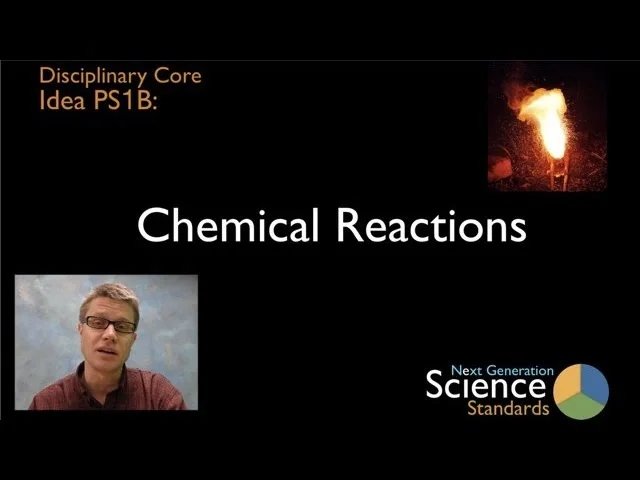PS1.B: Chemical Reactions
How do substances combine or change (react) to make new substances? How does one characterize and explain these reactions and make predictions about them?
K-12 Progressions
| K-2 | 3-5 | 6-8 | 9-12 |
|---|---|---|---|
| Heating and cooling substances cause changes that are sometimes reversible and sometimes not. | Chemical reactions that occur when substances are mixed can be identified by the emergence of substances with different properties; the total mass remains the same. | Reacting substances rearrange to form different molecules, but the number of atoms is conserved. Some reactions release energy and others absorb energy. | Chemical processes are understood in terms of collisions of molecules, rearrangement of atoms, and changes in energy as determined by properties of elements involved. |
Grade Band Endpoints for PS1.B
By the end of grade 2. Heating or cooling a substance may cause changes that can be observed. Sometimes these changes are reversible (e.g., melting and freezing), and sometimes they are not (e.g., baking a cake, burning fuel).
By the end of grade 5. When two or more different substances are mixed, a new substance with different properties may be formed; such occurrences depend on the substances and the temperature. No matter what reaction or change in properties occurs, the total weight of the substances does not change. (Boundary: Mass and weight are not distinguished at this grade level.)
By the end of grade 8. Substances react chemically in characteristic ways. In a chemical process, the atoms that make up the original substances are regrouped into different molecules, and these new substances have different properties from those of the reactants. The total number of each type of atom is conserved, and thus the mass does not change. Some chemical reactions release energy, others store energy.
By the end of grade 12. Chemical processes, their rates, and whether or not energy is stored or released can be understood in terms of the collisions of molecules and the rearrangements of atoms into new molecules, with consequent changes in total binding energy (i.e., the sum of all bond energies in the set of molecules) that are matched by changes in kinetic energy. In many situations, a dynamic and condition-dependent balance between a reaction and the reverse reaction determines the numbers of all types of molecules present. The fact that atoms are conserved, together with knowledge of the chemical properties of the elements involved, can be used to describe and predict chemical reactions. Chemical processes and properties of materials underlie many important biological and geophysical phenomena.
Introduction to PS1.B
Many substances react chemically with other substances to form new substances with different properties. This change in properties results from the ways in which atoms from the original substances are combined and rearranged in the new substances. However, the total number of each type of atom is conserved (does not change) in any chemical process, and thus mass does not change either. The property of conservation can be used, along with knowledge of the chemical properties of particular elements, to describe and predict the outcomes of reactions. Changes in matter in which the molecules do not change, but their positions and their motion relative to each other do change also occur (e.g., the forming of a solution,a change of state). Such changes are generally easier to reverse (return to original conditions) than chemical changes.
“Collision theory” provides a qualitative model for explaining the rates of chemical reactions. Higher rates occur at higher temperatures because atoms are typically moving faster and thus collisions are more frequent; also, a larger fraction of the collisions have sufficient energy to initiate the process. Although a solution or a gas may have constant chemical composition—that is, be in a steady state—chemical reactions may be occurring within it that are dynamically balanced with reactions in opposite directions proceeding at equal rates.
Any chemical process involves a change in chemical bonds and the related bond energies and thus in the total chemical binding energy. This change is matched by a difference between the total kinetic energy of the set of reactant molecules before the collision and that of the set of product molecules after the collision (conservation of energy). Some reactions release energy (e.g., burning fuel in the presence of oxygen), and others require energy input (e.g., synthesis of sugars from carbon dioxide and water).
Understanding chemical reactions and the properties of elements is essential not only to the physical sciences but also is foundational knowledge for the life sciences and the earth and space sciences. The cycling of matter and associated transfers of energy in systems, of any scale, depend on physical and chemical processes. The reactivity of hydrogen ions gives rise to many biological and geophysical phenomena. The capacity of carbon atoms to form the backbone of extended molecular structures is essential to the chemistry of life. The carbon cycle involves transfers between carbon in the atmosphere—in the form of carbon dioxide—and carbon in living matter or formerly living matter (including fossil fuels). The proportion of oxygen molecules (i.e., oxygen in the form O2) in the atmosphere also changes in this cycle.
Performance Expectations Associated with PS1.B
K-2
2-PS1-4
VIDEOS
Next Generation Science Standards is a registered trademark of Achieve. Neither Achieve nor the lead states and partners that developed the Next Generation Science Standards were involved in the production of this product, and do not endorse it. Visit the official NGSS website.


